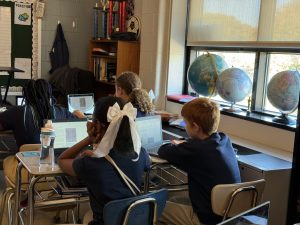 Teaching civic engagement and civic responsibility to middle schoolers is always interesting. This particular presidential election and moment in our country’s polarized political climate makes it especially interesting.
Teaching civic engagement and civic responsibility to middle schoolers is always interesting. This particular presidential election and moment in our country’s polarized political climate makes it especially interesting.
Civics instruction is important from a young age because students oftentimes feel powerless at their age. They know that adults are making decisions that impact their lives, and they don’t have a say in those decisions. Understanding the process of how those decisions are made can ease some of the anxiety students feel about the government. For example, in my classes, we’ve talked a lot about climate change this year, and my students struggle to understand why no one is doing anything to solve the problems. It’s a very relevant issue for them and their future.
The Role of Civic Education and Civic Engagement
Maryland public schools are not required to teach a civics curriculum. It’s typically taught as part of the middle school social studies curriculum in geography, U.S. history, and world history classes. Civic education is important because it helps people become informed and active citizens, and it’s a vital part of a democracy.
When students understand our system of government, though, they can better understand why our society has difficulty solving issues. When kids are 11 and 12, they are really just getting exposed to what it means to be civic engaged. I believe that as a society, we have a lot of work to do to get the kids motivated, engaged, informed, and feeling like they have power to actually make the change.
I begin by explaining that civics is a process of decision-making. The curriculum I use is modeled on the U.S. Articles of Confederation. I introduce the topic by having them break into 13 different groups to choose a movie for the class to watch. I explain that we need nine of the groups to come to a consensus.
Finding consensus in this exercise never works. From there, we talk about how groups of people make decisions and the pluses and minuses of each option. I explain that it’s impossible for 350 million people to vote on one thing, so we choose representatives to vote for us.
Introducing Civic Engagement in the Middle School Classroom
 This fall, I am teaching the 7th grade about elections and the role of citizenship. Why is it important to understand decisions and to make informed decisions? We analyze sources from history, examine the websites and goals of the different parties. It’s important for them to break down the biases within each party to make better decisions.
This fall, I am teaching the 7th grade about elections and the role of citizenship. Why is it important to understand decisions and to make informed decisions? We analyze sources from history, examine the websites and goals of the different parties. It’s important for them to break down the biases within each party to make better decisions.
Part of this is understanding, but perhaps not agreeing with, another person’s point of view. In the beginning of the year, I emphasize that in class, we are arguing ideas, not against people. Students need to understand that it’s OK to dispute ideas and not place a value on someone based on an idea. Many kids this age are uncomfortable speaking up. Creating an environment of trust and respect means that they can speak their mind and maybe say something wrong and they’re not going to get vilified by their classmates.
Educating Students to Recognize Misinformation
We use several resources from the Digital Inquiry Group, formerly the Stanford History Education Group. We talk about the three steps to take when looking at a source:
 What or who is behind the information? What do I know about the organization or person?
What or who is behind the information? What do I know about the organization or person?- What’s the evidence that they’re using in this source? Are they presenting any evidence at all?
- What do other sources say? This is the one I emphasize the most, to encourage them to check multiple sources to corroborate or contradict what the first source is saying.
Creative Strategies for Teaching Civics
It’s important to make any talk of civics or politics relevant for kids. A lot of political issues and government policies and procedures feel so far from their daily lives. Last year, with the 8th grade, I used the example of Congress trying to ban TikTok for a deeper discussion on the three branches of government and how a bill gets passed or rejected. Find information or current events that they care about to start a discussion. Our students care deeply about local news and what’s happening around Baltimore. Any time I can bring local issues in, I see the engagement go way up.
Below are suggested books to help with these types of discussions at home:
Picture books, Grades PreK-5th
 Madam President by Lane Smith
Madam President by Lane Smith
Sofia Valdez, Future Prez by Andrea Beaty
I Voted: Making a Choice Makes a Difference by Mark Shulman
Lillian’s Right to Vote by Jonah Winter
Equality’s Call: The Story of Voting Rights in America by Deborah Diesen
Vote for our Future! By Margaret McNamara
 Middle Grades
Middle Grades
Act by Kayla Miller
Votes of Confidence: A Young Person’s Guide to American Election by Jeff Fleischer
You Call THIS Democracy? How to Fix Our Government and Deliver Power to the People by Elizabeth Rusch
